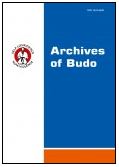2017, Volume 13
Monitoring training during four weeks of three different modes of high-intensity interval training in judo athletes
Braulio Henrique Magnani Branco1, João Paulo Lopes Silva2, Jonatas Ferreira da Silva Santos2, Ursula Ferreira Julio2, Valéria Leme Gonçalves Panissa2, Emerson Franchini2
1Department of Physical Education, University Center of Maringá (UNICESUMAR), Maringá, Brazil
2School of Physical Education and Sport, University of São Paulo, São Paulo, Brazil
Author for correspondence: Braulio Henrique Magnani Branco; Department of Physical Education, University Center of Maringá (UNICESUMAR), Maringá, Brazil; email: brauliomagnani[at]live.com
Full text
Abstract
Background and Study Aim: Ideal control of training load and physiological recovery between training sessions and competitions are important aspects for training periodization and improve performance in competition. The aim of this study was the effects of 4-weeks of three different modes of high-intensity interval training (HIIT) on the heart rate variability (HRV), as well as perceptual, physiological and psychometric responses among judo athletes.
Material and Methods: Thirty-five judo athletes were randomized into three training groups: 2 blocks of 10 sets of 20s all-out effort by 10s recovery twice a week using lower-body [high-intensity exercise (HIE) in cycle-ergometer for lower-limbs with 4.5% of body mass]; upper-body (HIE in cycle-ergometer for upper-limbs with 3% of body mass); uchi-komi (HIE by means of technique-entrance) and a control group (judo trained only). The HRV was monitored at rest at the beginning of each week. The frequencies analysed were the root mean square of successive differences in the R-R intervals (rMSSD) and rMSSD/MRR (mean of R-R intervals) ratio. Blood samples were collected to measure hormone concentrations [free-testosterone and cortisol] and cellular damage markers [creatine kinase (CK), lactate dehydrogenase (LDH), aspartate aminotransferase (AST) and alanine aminotransferase (ALT)] before and after the training period. The ratings of perceived recovery (RPR) and exertion (RPE) were reported in each HIE-session. The psychometric questionnaires were applied weekly.
Results: There was no difference for HRV, RPE, internal training load, psychometric questionnaires, hormonal levels, CK, AST and ALT (p>0.05). There was a moment effect for the uchi-komi group, with higher values for RPR in the first HIE-session when compared to the second (p = 0.014) and an increase of LDH to the upper-body group (p = 0.031) after 4-weeks.
Conclusion: Thus, low-volume HIIT promoted only a moment effect for RPR in uchi-komi group and an elevation of LDH in the upper-body after 4-weeks.
Key words: physiological recovery, fatigue, combat sports, sports performance




